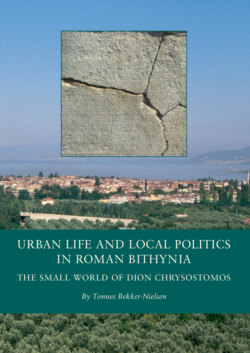Читать книгу Urban Life and Local Politics in Roman Bithynia - Tonnes Bekker-Nielsen - Страница 15
На сайте Литреса книга снята с продажи.
Inscriptions
ОглавлениеThe legal sources in turn provide a frame of reference for interpreting the documentary evidence provided by the epigraphic sources. We are fortunate to possess a significant body of Bithynian inscriptions, of which the two most important categories for our purposes are civic inscriptions and funerary epitaphs. The civic inscriptions are often honorific in character; they record the achievements of individuals or groups of persons and usually include a detailed description of the honorand’s career as well as the names and sometimes also the status and titles of the dedicant(s).26 Funerary inscriptions tend to be less detailed and shorter, but may include family relationships and other information not found in the honorific inscriptions; also, they cover a slightly wider social spectrum. A further advantage of funerary inscriptions is that they provide a complete biography of the person up to his death.
Within Bithynia, the civic inscriptions of Prusias ad Hypium (mod. Konuralp) form a special group that must be taken into account in any discussion of Bithynian urban life. In the mid-third century, Prusias ad Hypium was hastily fortified in anticipation of a Gothic siege.27 Numerous inscribed stones and slabs were incorporated into the walls and thus preserved for posterity, providing the most complete epigraphic record for civic life in Bithynia generally. For instance, of the 64 Bithynian archons whose names have been recorded for posterity, 45 are from Prusias ad Hypium; of 26 Bithynian agonothetes, 22; and eight out of ten censors.28 Though Prusias ad Hypium was located some distance from the three cities that are at the focus of this study, its inscriptions are indispensable for a deeper understanding of Bithynian municipal government.
This raises the wider question of how, and to what extent, it is possible to draw parallels from one city to another, or even from one province to another. Some studies, such as the recent work by Dimitriev (2005), are based on the assumption that city administration followed similar patterns throughout Asia Minor; hence, information about conditions in one city may – in the absence of evidence to the contrary – be taken to cover all cities in the region. The attraction of this approach is that once it is accepted that city power structures were the same throughout, the fragments of information that we possess can be combined into a “standard” civic structure. Two problems, however, need to be taken into account. The first is that although certain legal principles and practical procedures apply throughout the provinces of the Roman Empire (e.g., the right of appeal of a Roman citizen), before the third century there were few serious attempts at harmonization of local and regional administrative structures.
The second is that the Roman vocabulary for administrative offices was limited and highly adaptable. The terms legatus, curator, decurio, prafectus or tribunus had a wide range of meanings and could apply to civilian and military positions alike. Unless their nature is specified by the addition of a qualifying noun (e.g., curator civitatis) one cannot be sure that they refer to identical or similar functions. Greek designations for urban offices such as logistês, epimelêtês, prostatês, logothetês etc. likewise cover a fairly wide semantic spectrum; and as noted by Dölger in his study of Byzantine administration, titles persist even when the nature of an office changes over time,29 just as the praetorian prefecture of the fourth century had nothing in common with the office of praetorian prefect under the early empire.
It also needs to be remembered that in what we may call biographical inscriptions – a category that includes both honorific and funerary inscriptions – what is recorded may be exceptional rather than typical, and that there is a strong social bias. Inscriptions on stone or bronze were expensive, and we do not find many working-class heroes in the epigraphic record.
Finally, formal inscriptions provide an incomplete and one-sided view of Greek perceptions of the ruling power: hostile attitudes could be voiced in the agora or elsewhere, but writing them down was a different matter. Only in exceptional cases we do find hostility expressed in the epigraphical record, for instance by a citizen of Kourion in Cyprus who put a curse on the Roman governor in connection with a court case.30
